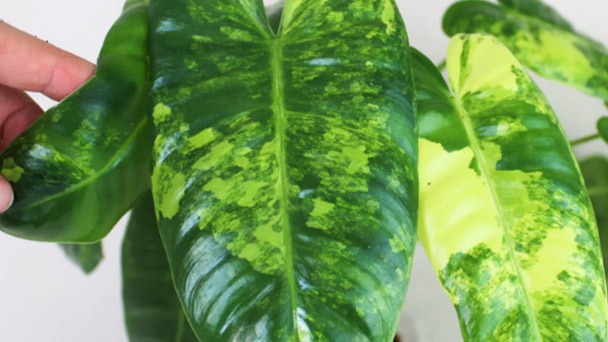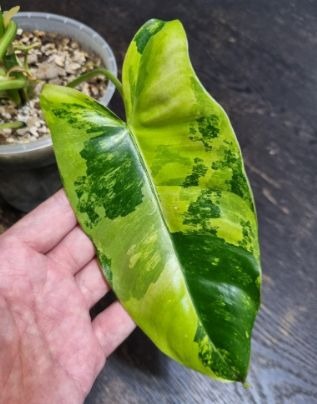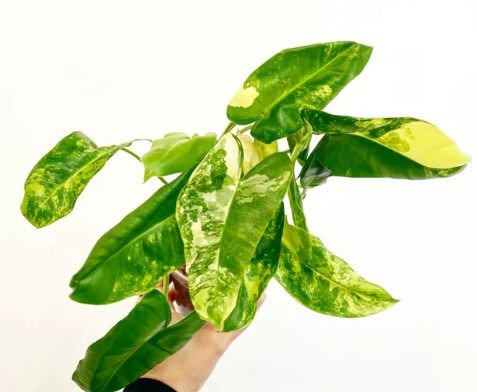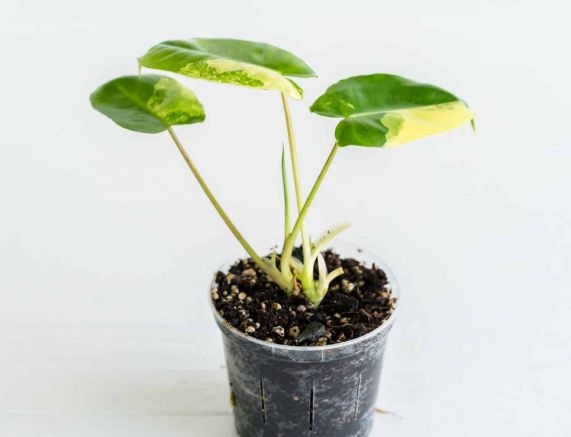Philodendron Burle Marx Care Guide 2023
Written by Ivy
Jan 07 2023

The Philodendron Burle Marx is a great choice if you want a fast-growing, low-maintenance plant that will enhance the tropical and exotic feel in your home.
Roberto Burle Marx, the first architect to use a native plant in a modern design, inspired the name of this low-growing tropical shrub. This plant is well-liked not only for its beauty but also for its simplicity in cultivation; anyone can grow it.
Philodendron Burle Marx Overview
| Scientific Name | Philodendron imbe ‘Burle Marx' |
| Common Name | Philodendron Burle Marx |
| Light | Bright indirect sunlight |
| Watering | Water if the top two inches of soil are dry |
| Temperature | 64 to 79°F (18 to 26°C) |
| Hardiness Zone | 9b to 11 |
| Humidity | 50 to 80% |
| Soil Type | Rich, quick-draining, loamy |
| Soil pH | 5.6 to 6.5 (acidic to mildly acidic) |
| Fertilizing | A balanced feed twice a month in spring and summer |
| Repotting | Every 2 years |
| Pruning | Spring or fall |
| Propagation | Stem cuttings or air layering |
| Toxicity | Toxic to humans and pets |
| Mature Size | 2 to 3 feet as a houseplant |
| Bloom Time | Rarely blooms indoors |
About Philodendron Burle Marx

Philodendron Burle Marx is cultivated in pots as a houseplant even though it makes a wonderful ground cover or outdoor plant.
It is a climbing plant that can be oriented however you like so that it grows in different directions.
It has lovely, exotic foliage that resembles a jungle, and the leaves are a deep green color.
If given the right conditions, it is a plant that grows quickly and spreads out very quickly.
Its exciting and tropical vibe is further enhanced by the fun-looking, red color of its stem. You can direct the growth of this climbing indoor plant in any direction to suit your preferences. You could also plant this in a hanging basket and then shape the stems to fit your house for a more aesthetically pleasing result.
If you're not the most patient gardener, you can still enjoy a fully grown plant right away because it grows and spreads quickly in the ideal growing environment. Since the Victorian era, they have enjoyed enormous popularity as indoor plants, just like other philodendrons.
The philodendron is a very well-liked plant to grow because of how simple it is to grow and spread it, as well as how attractive it is. In addition to these benefits, they are known to aid in the airborne toxin removal process.
However, note that the plant contains high amounts of calcium oxalate crystals, which can negatively affect our body and immune system. Do not ingest any parts of this plant, and make sure that it is out of the reach of children and pets.
Philodendron Burle Marx Care
The next step is to learn how to take care of the Burle Marx Philodendron plant that you are now more familiar with.
It doesn't need a lot of maintenance, but it still has specific requirements and prefers a certain environment for growth. Its needs are similar to philodendrons, so follow these tips below:
Light Requirements
When it comes to light, this plant requires bright and indirect light for it to thrive properly. It can survive in low light, but it won't grow as well as you might anticipate.
Direct sunlight, on the other hand, will burn your plant's leaves because the light will pass right through them. The leaves of your plant will either get black scorch marks or at least get discolored, turning yellow.
Put your plant in a spot with an east or north-facing window to provide it with indirect light. By doing this, you can give your plant bright light that isn't from the sun.
Water Requirements
Like other philodendrons, your Philodendron Burle Marx requires similar care when it comes to watering. Keeping the soil moist and striking the right balance are the objectives. Its soil shouldn't be completely dry, but you also shouldn't completely drench it.
Your plant will be more susceptible to a number of diseases, including root rot and other plant damage, if you overwater it. Take the plant outside to inspect the root damage if you suspect that you overwatered your plant. Use a sterilized pruning tool to prune the harmed areas of the roots if only a small portion of them is in danger. There isn't much that can be done to save a root if the majority of its components are in danger.
As the seasons change, so do the watering needs. Water it frequently (typically once a week or so) to keep it moist during the spring and summer. When winter arrives, you can wait until the soil has dried out before watering your plant.
Soil Requirements
This plant requires well-draining soil to ensure that excess water will drain from its pot. This will stop extra moisture from accumulating in its soil. When the soil is saturated, oxygen cannot reach the roots, which leads to root rot.
When the roots of your plant start to rot away, it can lead to a serious condition called root rot. The roots will turn brown or black and begin to smell like they are rotting or have mildew. This kills your plant because it spreads rapidly before you can stop it. Consequently, you should use high-quality soil to avoid this from happening.
Although it won't require organic soil, this plant does enjoy organic materials. Sphagnum peat moss, which has excellent aeration so that extra water doesn't stay if you overwater, can be used as soil. Additionally, the peat moss will store water for the plant.
Peat-perlite, which functions similarly to peat moss, is an additional choice. Use materials other than clay or ones that resemble clay instead because they can't hold the volume of water your plant needs.
In addition, the pH of the soil should be between 5.6 and 6.5, which is either mildly acidic or acidic.
Temperature and Humidity
When talking about the optimum temperatures for this plant, the Philodendron Burle Marx prefers room temperatures between 60 to 75 degrees F. In comparison to other houseplants, they can also withstand lower temperatures. Your plant will stop growing if you allow the temperature to fall below 50 degrees Fahrenheit or if it is exposed to frost.
The Philodendron Burle Marx prefers higher relative humidity levels. Although the plant can survive in environments with lower humidity levels, it won't grow as well as you'd like. They cannot survive or grow at all if they are in places with completely dry air.
Fortunately, there are things you can do to maintain proper moisture in the air to copy the tropical climates the plant would thrive in, such as the following:
- Improve the humidity in the space where your plant is by using a humidifier. Though it might be a bit pricey.
- Use a spray bottle to mist your leaves. Moisture will be created around your plant as a result of the water evaporating. However, unless you can precisely measure the humidity level with other tools, it's challenging to control.
- A popular and inexpensive method to raise the humidity in the space is to use a pebble tray. Pour water into a tray that has been filled with pebbles, making sure that the water level is nearly at the top but not touching the stones. So that evaporating air will reach the plant directly, place your plant on top of the tray.
Fertilizer
Use a slow-release fertilizer or an all-purpose fertilizer that should be applied at half-strength when fertilizing your plant. Whichever type of fertilizer is applied, you want one with a higher concentration of nitrogen because this will cause the leaves to grow and glow.
During its growing season, fertilize the plant once a week. Because it grows quickly, be aware that these plants are heavy feeders. However, when the colder months come in, you'll only have to fertilize your Philodendron Burle Marx once a month or you can cease fertilizing until the growing season returns.
Your plant needs moisture in the soil, so water it before fertilizing. Your plant's roots could become damaged if you fertilize it while the soil is still dry.
Although you can grow this plant without fertilizer, it's best to use the right kind of fertilizer if you want it to thrive. Leaving your plant unfed won't harm it or make it more susceptible to fatal diseases; it will just slow down its growth.
Potting and Repotting
When a plant's roots start to ball up and compact, it's time to repot it. The plant's roots won't be able to spread out and expand further if this occurs. Additionally, it's best to repot your plant early in the growing season (early spring or later in the winter) before new growth starts.
The new pot for this plant should only be 2–3 inches larger than the one it is currently in.
Pruning
Pruning of Philodendron Burle Marx is not really necessary.
Cutting Philo Burle Marx is primarily done to get rid of dead or damaged leaves, and you should do it whenever you see them throughout the year.
Philodendron Burle Marx grows into a compact plant naturally, so you shouldn't need to prune it for size.
Cutting just above a leaf node on the stems will allow you to prune it in order to control its upward or sideways spread.
Either early spring or late fall are suitable times for this pruning. When cutting your Philodendron Burle Marx, always use clean scissors or knives.

Philodendron Burle Marx Propagation
The Philodendron Burle Marx can be propagated or you can start planting it from seeds. The Philodendron Burle Marx can be propagated using one of two techniques.
Stem Cuttings
Follow these steps when doing this method:
- You should be aware of the ideal stem cutting for your Philodendron Burle Marx prior to cutting. Cut this at the point just below the leaf node, which should be between two and four inches long. Using isopropyl alcohol, sterilize your pruning shears before gathering your stem cuttings.
- After receiving your stem cutting, you must cure it. Allow it to sit in a warm area for seven to ten days. You'll notice that one of the cutting's ends will calluse over during this time. The calloused end indicates a higher likelihood that the cutting will root when planted.
- You can prepare the pot and soil while your cut is curing. Sphagnum peat moss and a pot with drainage holes are the two things we advise using for the soil.
- Plant the stem cutting after the curing period is finished. Using your finger, dig a few inches-deep hole, insert the stem cutting, and fill the hole with soil. You can secure the stem cutting to a straw for support if it isn't standing straight up. Place the pot in an east or north-facing window and give it the same care as you would the mother plant, including watering and fertilizing.
- You will notice that the stem cutting is rooting after about two months.
Air Layering
When you are following the air layering process, follow these steps:
- The first step is to stab your mother plant with a sharp, isopropyl alcohol-sterilized knife. When ready, make a 2-inch-long, 2-inch-deep wound on the plant's stem.
- After cutting, insert a toothpick through the plant's wound and place it so that it won't close. The wound ought to be visible and accessible.
- Grab some sphagnum peat moss and slightly moisten it. After that, massage the peat moss all the way around the wound and stem. Peat moss that has been moistened will adhere more readily.
- In order to hold the wound, get a string and tie it around the stem and peat moss. If the peat moss is already adhering to the wound, skip this step.
- Wrap the plant's wound and stem in plastic wrap. Wrap tightly, but leave enough room for oxygen to enter. Use duct tape to secure the wrap if it won't stick by itself.
- Prepare the soil and plant pot while you wait for the roots to appear. Use a pot with drainage holes and well-draining soil.
- You'll notice peat moss and roots emerging from the wound in about three weeks. Remove the plant from the mother plant by making cuts above and below the peat moss when the roots are 3 inches long.
- Remove the plastic wrap now with extreme caution to protect the roots of your new plant. The brand-new Philodendron Burle Marx is now available for planting. For it to grow well, make sure the roots are buried in the ground.
- Regardless of the fact that your new plant might not yet resemble the mother plant, you should still treat it as if it were one.
Philodendron Burle Marx Problems
The Philodendron Burle Marx is a low-maintenance plant, but you might run into a few minor problems, which are fairly simple to fix once they occur.
1. Pest Infestation
A Philodendron Burle Marx doesn't have a problem with pests, just like other philodendron varieties. However, a few pests might manage to get close to the plant.
The thrip, a tiny insect that resembles a small thread, is one common plant pest. The weak wings on these pests prevent them from flying very far; instead, they hover for a brief period of time before descending.
Thrips would eat the sap from your plant, piercing the plant with their mouths to get to the sap, and sucking it like they were drinking from straws. This is NOT good because your plant depends on the sap to transport nutrients and water. It can result in pretty serious consequences, including death, if untreated.
Mealybugs are another typical pest that the Philodendron Burle Marx might encounter. They have cotton-like materials wrapped around them and have an awkward appearance. Since their bodies are soft, that substance is what shields them. If you notice cotton around your plant's leaves, you may have a mealybug infestation.
The infestation will become more severe as mealybugs quickly multiply. Mealybugs would suck sap from your plant, similar to thrips, which could cause it to die.
Neem oil can be used to get rid of bugs and stop them from hurting your plant. Twice a week, until there are no longer any indications of bugs around your plant, spray neem oil around it and wipe down the infected leaf or leaves.
2. Brown Leaves
Your Philodendron Burle Marx has brown leaves for a number of reasons.
It could be caused by overwatering or by not getting enough humidity. However, you can rule out that explanation if your plant has evolved to function at lower humidity levels. You can eliminate this possibility as well if your soil isn't saturated.
Salt buildup in the soil is the second reason for browning leaves. Your plant's soil receives salt when you fertilize it. It might become oversalted after receiving numerous feedings, in which case your soil would become contaminated. A plant that consumes too much salt may become ill.
By carrying out a soil flush every few months or only when necessary, you can get rid of the salt. Use a slow flow when turning on your hose or faucet to accomplish this. Allow the water to thoroughly cover the soil where the plant is located. Salt will be forced from your pot's drainage holes by the water.
3. Wilting Leaves
Your plant is underwatered if you notice that the leaves are starting to wilt. Your plant will become dehydrated if you submerge it. It needs to survive and perform photosynthesis because it is lacking in water.
Underwatering will have consequences similar to overwatering if it is a problem. By examining the soil, you can determine whether the soil is the cause of your leaves' wilting. Your plant doesn't get enough moisture if the ground is dry even a few inches down.
Fix this by giving your plant some water right away. Then, every three to four days, check the soil to see if it still needs watering. Depending on the season, you might want to give the plant a regular watering schedule.
4. Leaves Dropping
Is your plant dropping a lot of leaves and losing leaves? If so, this might be a sign that it was this time overwatered. Check its soil before watering your plants as a result. It shouldn't be soaked in water.
It's best to replace the soil rather than allow the plant to grow on it if the soil is so saturated that it resembles the plant and remains saturated for a long time. It will prevent oxygen from reaching your plant's roots if it contains too much water, which will cause root rot. The key is to give your plant the right amount of water.
5. Water Spots
If there are water spots on your growing Burle Marx Philodendron's leaves, then you are most likely using hard water when watering your plant. It needs soft water to grow and thrive because it won't contain harsh minerals that will harm the leaves and development of your plant. If you only have hard water, leave it alone overnight to allow the chlorine and other chemicals to dissolve.

Summary
For those who enjoy unusual evergreen indoor plants, the Philodendron Burle Marx is ideal. Additionally, it isn't a demanding plant. It only requires sufficient filtered light, moderate room temperatures (between 60 and 75 degrees Fahrenheit), moderate humidity, and weekly watering.
FAQs
How to Grow Philodendron Burle Marx Indoors?
If kept in a warm, humid environment and given regular watering and fertilization, Philodendron Burle Marx can thrive in a pot.
How to Grow Philodendron Burle Marx Outdoors?
In tropical or subtropical regions, Philodendron Burle Marx can be grown outdoors year-round. In temperate regions, summertime movement of a potted plant outdoors is possible.
Is Philodendron Burle Marx Toxic to Cats?
Yes, cats are poisoned by Philodendron Burle Marx. Take your cat to the veterinarian right away if it eats some of the vegetation and then begins to vomit, wheeze, or have diarrhea.
How Fast Does Philodendron Burle Marx Grow?
The Philodendron Burle Marx grows quickly, gaining up to 2 to 4 inches per week during the spring and summer growing seasons.
Why is My Philodendron Burle Marx Drooping?
It may be getting too much or not enough water if your Philodendron Burle Marx is wilting. To proceed, evaluate the soil's moisture content and take appropriate action.
How Cold Can Philodendron Burle Marx Tolerate?
Below 60°F (15°C), Philodendron Burle Marx will begin to slow down, and at 50°F (10°C), it will begin to actually suffer damage. It will perish in subfreezing temperatures.
How to Get Rid of Pests on Philodendron Burle Marx?
The best way to keep insects off of your Philodendron Burle Marx is to wipe down the leaves once a month with an insecticidal soap or neem oil solution.
Latest Updated
- Benefits of Bugleweed - 7 Science-backed Health Benefits
- Bugleweed Dangers & Side Effects - Is It Poisonous?
- How to Plant Evergreen Trees - What You Should Know
- When to Plant Evergreens - Grow Guide for Evergreen Trees
- 12 Wonderful Evergreen Shrubs for Your Garden
- 12 Popular Evergreen Plants with Pictures for Beginners
- When And How To Prune A Lilac Bush Like a Pro
- How to Grow & Care for Lilac Vine (Hardenbergia Violacea)
- Japanese Lilac Tree (Syringa Reticulata) Care & Propagation Guide
- Shumard Oak Pros and Cons - What to Know
Popular Articles
- Winter maintenance of Antirrhinum Majus
- How to Grow Terminalia Mantaly Tree
- How to Grow and Care for Crossostephium Chinense
- How to grow Antirrhinum Majus in spring
- Peristeria Elata (Dove Orchid) Profile: Info & Care Guide
- Underwatered Snake Plant (Sansevieria Trifasciata) - Signs And How To Fix
- How to Care for Brazilian Jasmine Plant (Mandevilla Sanderi)
- How to Grow & Care for Graptopetalum Purple Delight in Summer
- Rosa Chinensis (China Rose): Plant Growing & Care Tips
- How to Care for Baby Sun Rose (Aptenia Cordifolia)